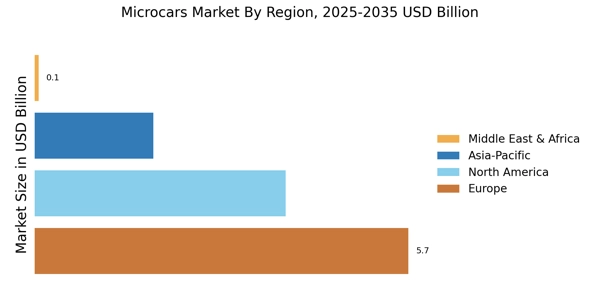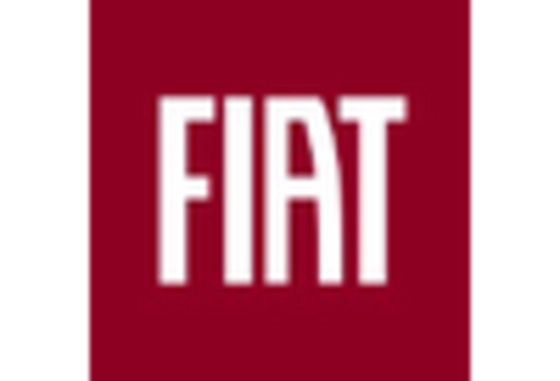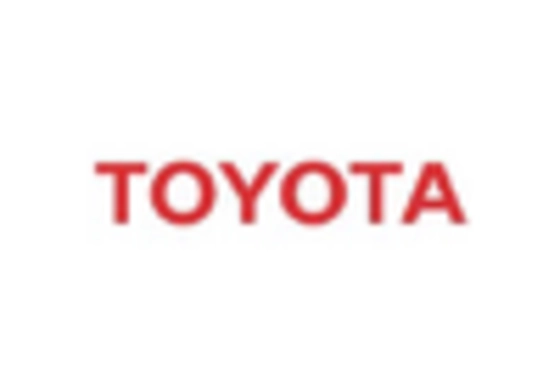Urbanization and Space Constraints
The increasing trend of urbanization is a pivotal driver for the Microcars Market. As more individuals migrate to urban areas, the demand for compact and efficient vehicles rises. Microcars Market, with their small footprint, are particularly well-suited for navigating congested city streets and fitting into limited parking spaces. According to recent data, urban areas are expected to house over 68% of the world's population by 2050, which suggests a growing need for vehicles that can accommodate the challenges of urban living. This trend not only enhances the appeal of microcars but also positions them as a practical solution for urban dwellers seeking mobility without the burden of larger vehicles. Consequently, the Microcars Market is likely to experience substantial growth as urbanization continues to shape transportation needs.
Rising Fuel Prices and Economic Factors
Economic factors, particularly rising fuel prices, are a notable driver for the Microcars Market. As fuel costs continue to fluctuate, consumers are increasingly seeking vehicles that offer better fuel efficiency and lower operating costs. Microcars Market, known for their economical fuel consumption, present a viable solution for budget-conscious consumers. Recent trends indicate that the demand for fuel-efficient vehicles has surged, with microcars often leading the way in this category. Additionally, economic uncertainties may prompt consumers to reconsider their vehicle choices, favoring smaller, more affordable options. Consequently, the Microcars Market is likely to thrive as individuals prioritize cost-effective transportation solutions in response to economic pressures.
Environmental Regulations and Sustainability
The Microcars Market is significantly influenced by the increasing emphasis on environmental regulations and sustainability. Governments worldwide are implementing stricter emissions standards and promoting eco-friendly transportation options. Microcars Market, often designed with fuel efficiency in mind, align well with these regulatory frameworks. For instance, many microcars emit lower levels of CO2 compared to traditional vehicles, making them an attractive option for environmentally conscious consumers. The market for electric microcars is also expanding, as advancements in battery technology enhance their viability. As a result, the Microcars Market is poised to benefit from a shift towards sustainable transportation solutions, with consumers increasingly favoring vehicles that minimize their carbon footprint.
Technological Advancements in Automotive Design
Technological advancements play a crucial role in shaping the Microcars Market. Innovations in automotive design, such as lightweight materials and improved safety features, enhance the appeal of microcars. The integration of smart technologies, including connectivity and autonomous driving capabilities, is also becoming more prevalent. Data indicates that The Microcars Market is projected to grow significantly, which may further drive the adoption of microcars equipped with advanced features. As manufacturers invest in research and development, the Microcars Market is likely to see a surge in models that not only meet consumer demands for efficiency but also offer enhanced driving experiences. This technological evolution could redefine consumer perceptions of microcars, positioning them as modern and desirable vehicles.
Changing Consumer Preferences and Lifestyle Trends
The Microcars Market is experiencing a shift in consumer preferences and lifestyle trends that favor smaller, more versatile vehicles. As urban lifestyles evolve, consumers are increasingly valuing convenience, affordability, and ease of use. Microcars Market cater to these preferences by offering compact designs that facilitate maneuverability in crowded environments. Furthermore, the rise of shared mobility services and car-sharing platforms has contributed to a growing acceptance of microcars as practical transportation options. Data suggests that younger generations are more inclined to embrace alternative mobility solutions, which may further bolster the Microcars Market. This changing landscape indicates a potential for sustained growth as microcars align with the evolving needs and desires of modern consumers.


















Leave a Comment